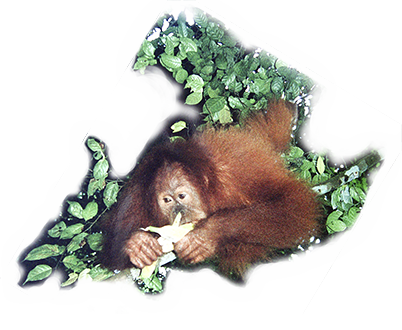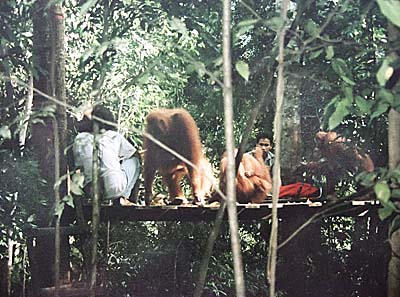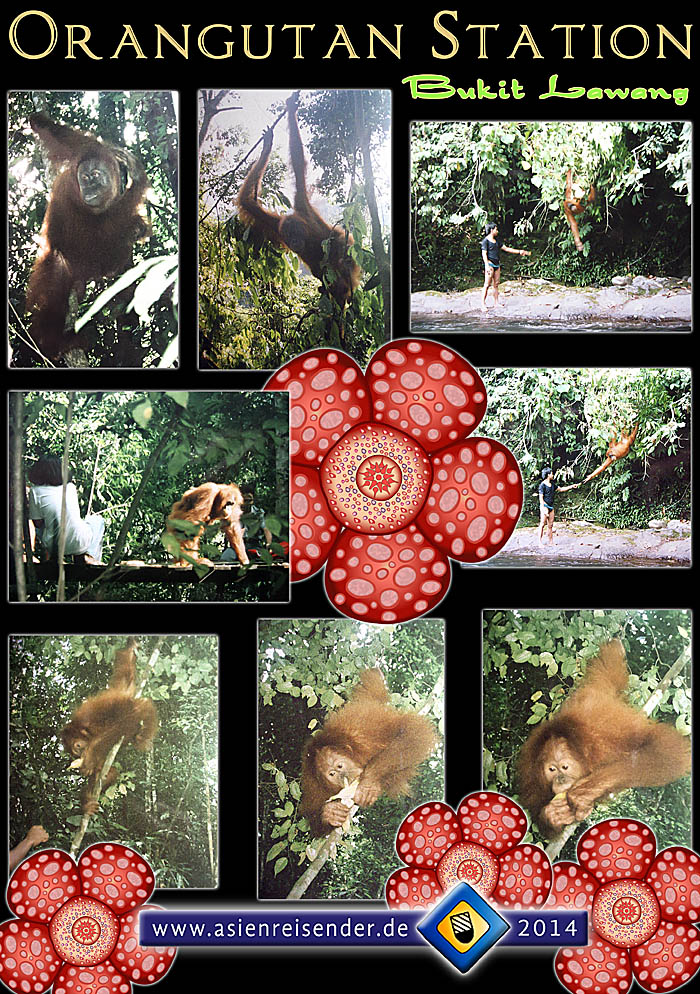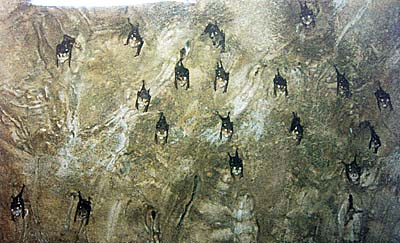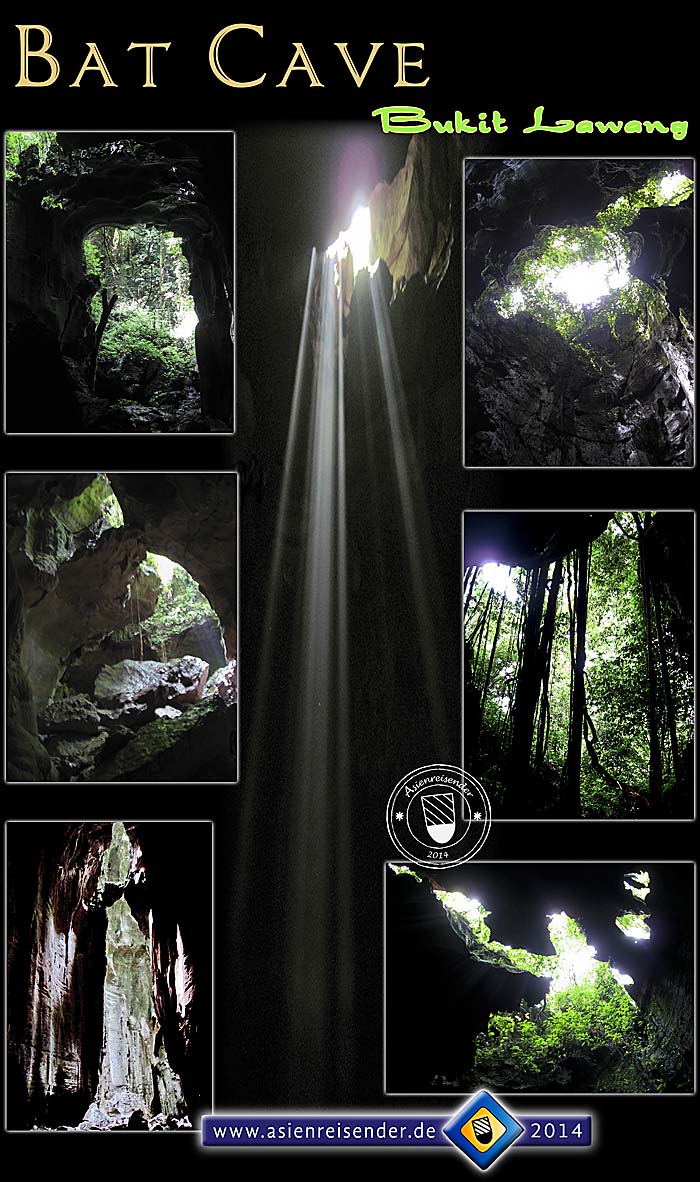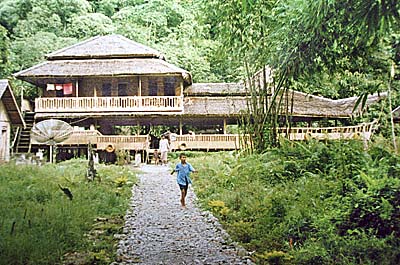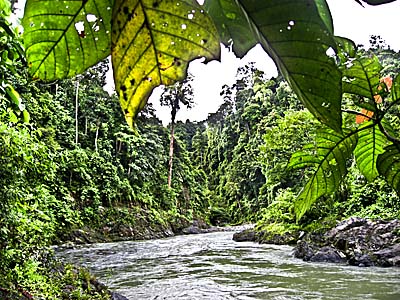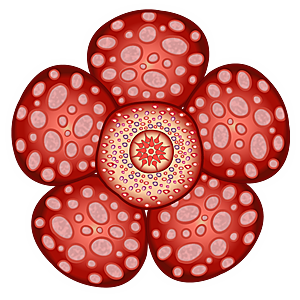1.
Bukit Lawang
About 84km westnorthwest of Medan, at the entrance of Gunung Leuser National Park, lies the little jungle village of Bukit Lawang (means: 'gate to the hills'). Bukit Lawang's fame came with the 'Orangutan Rehabilitation Center' there, which was founded in 1973.
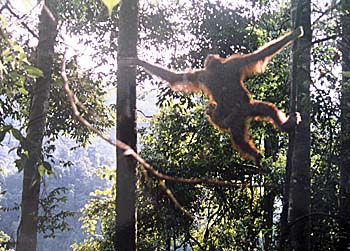
An orangutan mother with her baby in the trees of Gunung Leuser National Park near Bukit Lawang.
Image by Asienreisender, 1995
It's pretty sure that the place in this time was either extremely small or didn't already exist as a village. However, the little jungle nest became soon a tourist spot and started growing quickly. In the 1980s and 1990s the numbers of western tourists were rising, until the 1997/98 forest fires and the political turmoil in Indonesia. From then on the (western) tourist stream (arriving in Southeast Asia mostly in Bangkok) changed to the north, towards Laos and Vietnam, more and more also to Cambodia. The post-dictatorial Indonesian government restricted the visa conditions much to the worse and Westerners were rather repelled by the new, high visa fees and the (completely unnecessary) new buerocratic obstacles to visit Sumatra anymore. Now Bukit Lawang sees still a few, but far not as many western tourists as in the past. Therefore, on holidays and weekends are huge groups of local tourists invading the jungle nest at the banks of the Bohorok River. Many of them come from buzzing, chaotic nearby Medan, the biggest city in Sumatra.
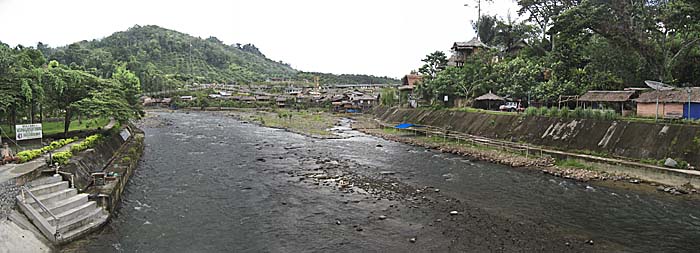
Bukit Lawang, a growing village at the shores of the Bohorok River.
Image by Asienreisender, 2009
The village itself grew also considerably in the past decades. When there were buildings only along the river in the 1990s, a new village came into existence just a few dozend meters away from it, protected from the water on an a bit more elevated spot.
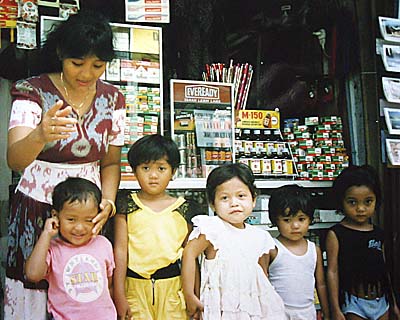
A shop owner with her children. Image by Asienreisender, 1995
In the last decade there was also a considerable growth of palmoil and rubber plantations. When coming from Medan, after leaving the monstrous megacity and reaching the green, the road leads all over the way to Bohorok and Bukit Lawang through huge, mostly palmoil plantations. Since rubber and palmoil are on the world market competing with food, and being more profitable than food is, there is meanwhile even a lack of rice in Indonesia. The country has to import rice since years now, what makes the food prices rise in such a poor country. Bukit Lawang is partially surrounded by these huge plantations, bordering the Gunung Leuser National Park with it's protected, tropical rainforest at the other side. By the way, the rainforest here is, according to informations I got in the 1990s, secondary jungle, about a hundred years old. Primary rainforest starts after a one or two days walk into the park, towards Gunung Leuser.
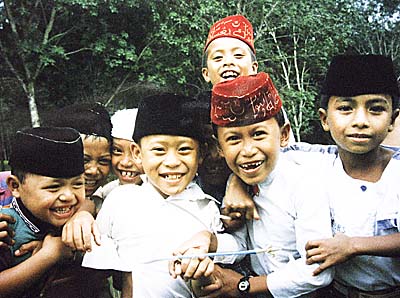
A group of pupils from the islamic school near the irrigation canal. Image by Asienreisender, 1995
The local economy is very much based on tourism. The Bohorok River is seamed with guesthouses of different quality and a number of restaurants and tourist shops. Since Bukit Lawang is a good place for jungle trekking, the villagers competition for selling organized tours is high. Almost any male villager between 16 and 60 years is a (self-declared) jungle guide. The verymost have absolutely no qualification for the job. They have no understanding for the ecosystem, know little about the animals and the plants. It's all about seeing the orangutans and making a few good photos of them. In the case of an accident in the jungle most of these guides certainly wouldn't know what to do.
Not all the inhabitants of the village are living from tourism; many, particularly those in the new village, are working in the plantations.
Exploring the tourist village of Bukit Lawang is a very easy thing. One only needs to follow the river upstream on the only, single path on each side. The track on the right side (riverdownwards) ends much sooner than the track on the other side. Since the flash flood (see below) has altered the river's flow and banks, it's no more possible to go that far upwards than it was in the past. At least not without crossing the river several times.

Bukit Lawang's new village, a few hundred meters away from the river. It's surrounded by plantations. Image by Asienreisender, 2009
The villagers have an open heart for customers and it is easy to come into talks with them. The restaurants/bars are mostly equipped with local gigolos, who have the very ambition to come in closer contact with the female part of the western visitors. The gigolos are unavoidably also jungle guides in personal union. If one comes in more talk with them, it often turns out that they are trophy collectors. It's about having 'adventures' with western tourists. That fits the taste of not few western complementaries. Sometimes it ends up with a marriage and a journey of the local to a western country. That's the greatest thing for a local womenizer; it's phantastic for his reputation and brings him quite some money respectively commodities. A few years and maybe a baby or two later they usually divorce again and Tarzan has to go back home.
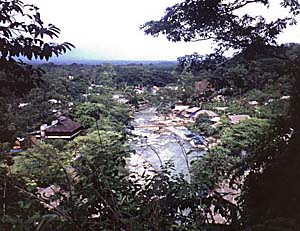
Bukit Lawang. Twenty years ago it was a much smaller place as it is nowadays. Image by Asienreisender, 1995
I have been a couple of times in Bukit Lawang already. Last time I spent some time with a Scottish fellow traveller. He decided to do a two-days jungle treck. When he was back next day, we sat together with his guide and talked a bit. On the guide's proposal we went with him into a bar he recommended. It turned out that it was full with easy girls and a transvestite. The girls joined (uninvited) our table and generously drank our beers. Thank's to them I remained pretty sober this evening. The guide, however, was pretty much in hope to bring us closer together. It's about commissions. I was happy when we left the sad place. My Scottish friend was quite a bit depressed that evening, for he felt dealt bad with in the last two days. If you stick to the wrong people here it can be very disappointing.
Map of Bukit Lawang
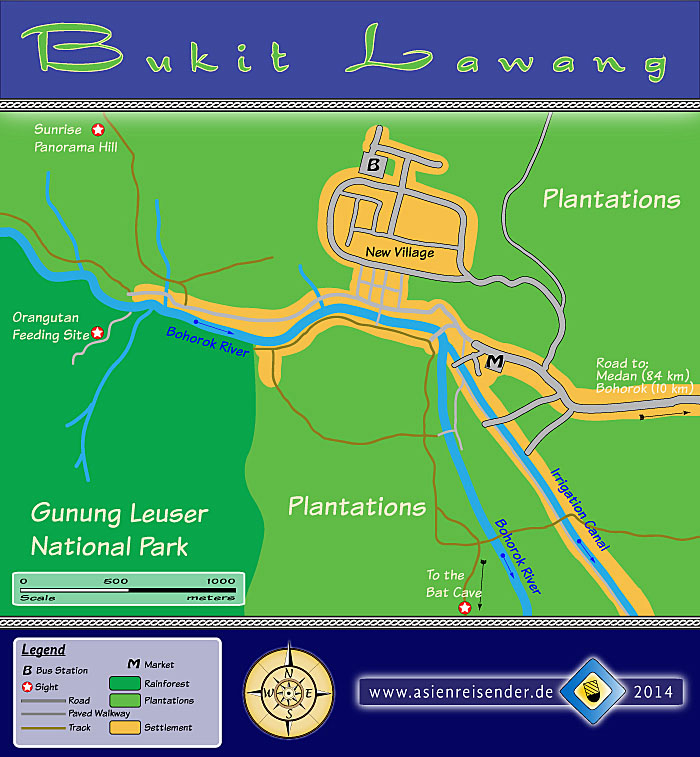
A sketch of Bukit Lawang. The upper part of the Bohorok River is seamed with guesthouses, restaurants and tourist shops. The new bus station is now a kilometer outside town, on the road from/to Medan (no more on the map). In the 1990s it was at the spot where the market (M) is now.
